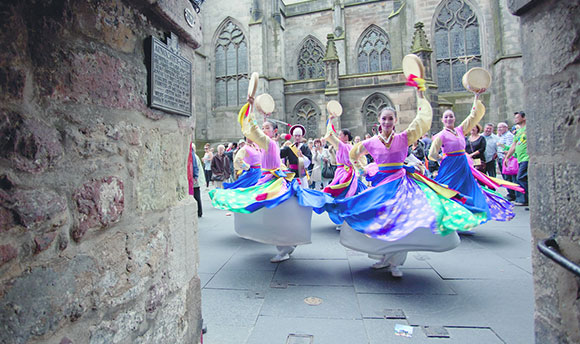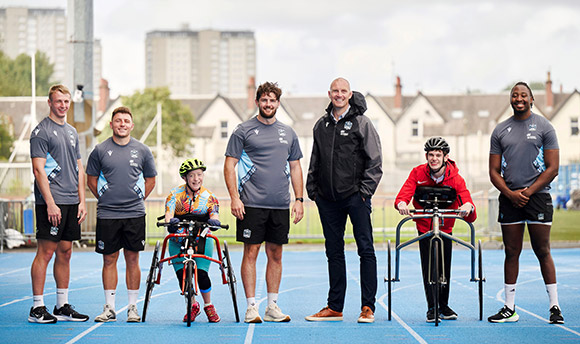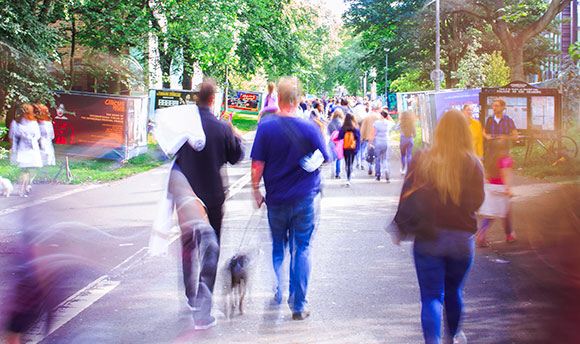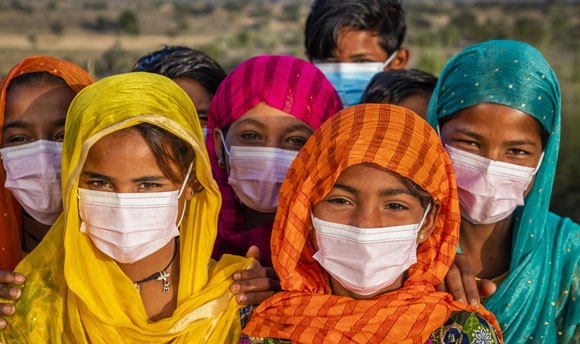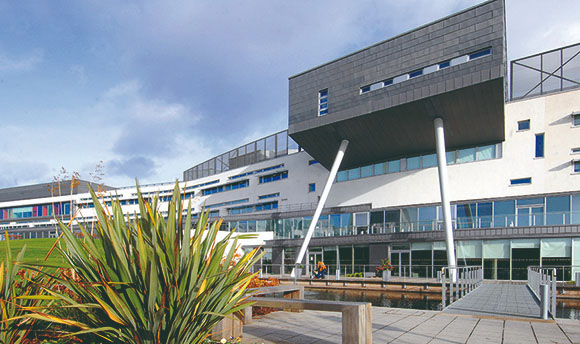QMU Understanding Creative Placemaking: A Literature Review
ASSaM/Media, Communication and Performing Arts
QMU Working Paper Series – 2020
Understanding Creative Placemaking: A Literature Review
Caitlin McKinnon & Anthony Schrag
1.0 Introduction
1.1 Who is the paper for?
This working paper, Understanding Creative Placemaking: A Literature Review, presents the first phase of commissioned research in relation to a major regional Placemaking project in Scotland. The purpose of this paper is to broaden the understanding of a specialised type of Placemaking known as Creative Placemaking and situate it within the broader practice, in order to consider how the broad notions of these terms relate to what is being developed in Scottish rural contexts.
This paper’s publication correlates with an increasing interest in placed-based approaches within Scottish cultural and economic policy and is likely to be of interest to a wide variety of different stakeholders including lecturers, researchers, leaders, practitioners as well as policymakers (Scottish Government, 2020; Scottish Government, 2022). As such, this paper has consulted both scholarly and ‘grey’ literature sources in an effort to provide a holistic understanding of this topic that may be useful to all interested parties.
1.2 What will this literature review will look like?
The paper is divided into two main sections with the first section seeking to highlight how Creative Placemaking can be understood in the broader context of the field and the second focusing on contextualising best practices, while also taking a particular look at Creative Placemaking in rural contexts. The paper concludes with an overview of what has been covered and points to an area where further research may be useful
2.0 Understanding Placemaking
2.1 Definitions and types: How do we define Placemaking?
Most articles, blogs and various other texts will start with a similar sentiment: that Placemaking has been an elusive term to define (Steuteville, 2016; Whittemore, 2016; Borrup, 2016; Cohen et al., 2018; Moore, 2020; American Planning Association, n.d; Kresge Foundation, n.d.). As Cohen et al. (2016, p.9) suggest the “somewhat-nebulous term, affords different meanings to different practitioners, professionals and academics”. In other words, different stakeholders interpret the varying definitions as it suits their personal circumstances best (American Planning Association, n.d.; Markusen & Gadwa Nicodemus, 2014, Kobersmith, 2021).
Broadly speaking, the development of the term Placemaking is linked to a concept within the cultural geography tradition known as a ‘sense of place’ which describes “how a culture group imprints its values, perceptions, memories, and traditions on a landscape and gives meaning to geographic space” (Lew, 2017, p.449). In the 1960s and 1970s, when the term grew in popularity, the concept shifted to encompass a “practice of community participation towards the development of distinctive and liveable places at the neighbourhood and block-level” (Borrup, 2016, p. 3). In 1995, scholar-practitioners Lynda Schneekloth and Robert Shibley highlighted Placemaking “is not just about the relationship of people to the places; it also creates relationships among people in places” (cited in Borrup, 2016, p.3).
The 2000s and 2010s saw organisations such as the Project for Public Spaces[1], call it a “collaborative process by which we can shape our public realm in order to maximize shared value” (2007, para.7). Others such as Steuteville (2016) describe Placemaking as the process of creating quality places, citing examples of “a building, location, or space that possesses a strong sense of place” and suggesting “it is a structure or space where people, businesses, and institutions want to be” (2016, para.4). The notion of ‘quality places’ was originally referenced in Wyckoff (2014).
[1]The PPS is a non-profit organisation, based in New York, dedicated to creating and sustaining public places that build communities. Since their inception in 1975, they have “worked in over 1,500 communities in the United States and around the world, helping people to grow their public spaces into vital community places” (PPS, 2005, para. 4). Over the years, they have created numerous resources and provided technical assistance and research to advance Placemaking efforts. A number of the articles found on their website can be considered seminal works in the larger body of literature and will be referenced throughout this paper.
considered a ‘place’, Wyckoff (2014, p.2) makes the distinction that a quality place is one that “people care about and want to be in” suggesting that this is because “those places have a strong sense of place”. Many people are likely to feel that way about their own homes.
The common thread amongst various definitions suggests that Placemaking refers to a kind of process that generates places where people want to be.
As a way to simplify this concept, Moore (2020, para.1) of Spaces to Places, provides the analogy of homemaking noting that “in the same way that homemaking is the process of turning a house into a home, Placemaking is the process of turning a space into a place”. This analogy is particularly useful as it lends itself to the notion that the process is adaptable as there is no one single way to make a home just as there is “no one-size-fits-all approach to building thriving, socially cohesive and self-sustaining communities” (Community First Oxford, 2017, p. 3).
2.2 What are the different types of Placemaking?
Some authors suggest that the contradictions found within the earlier literature on Placemaking (particularly within the ‘grey’ literature), “undermines the term’s ability to help neighbourhoods and communities imagine and create a better future” (Steuteville, 2016, para.1). However, it seems that the vagueness of the general concept has served its purpose, in being able to accommodate the wide range of practices that it encompasses, including variations in approach, type, method and purpose. The (2015) Wyckoff et al. paper categorising Placemaking into four types is therefore advantageous to those hoping to understand the term in modern practice. This is demonstrated in that the work has become the standard reference in the growing field (Steuteville, 2016; Lew, 2017; Cohen et al., 2018). Though the definition of each category has changed slightly when described by various organisations and academics, the categories of Standard, Strategic, Tactical and Creative have remained consistent. The relationship between the four types of Placemaking is illustrated in Figure 1 below.
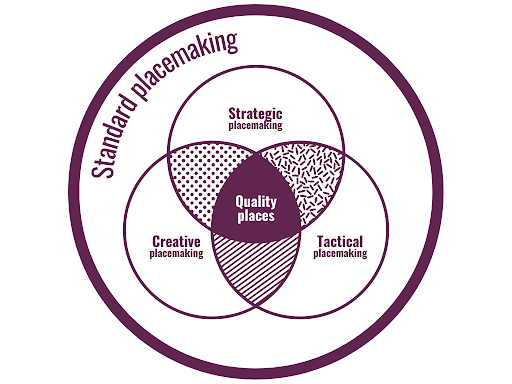
Figure 1: The relationship between the types of Placemaking (Source: Wyckoff, 2014)
While this paper’s focus is on Creative Placemaking, it is important to understand that the three specialised Placemaking types may also be a part of a standard Placemaking process (Wyckoff et al., 2015; Lew, 2017; Cohen et al. 2018). Below, the types are defined as:
1) Standard Placemaking: As Wyckoff (2014, p.5) suggests “Standard Placemaking (or just plain Placemaking) is the universal term”. This process adopts a wide range of practices and activities and is characterised by “incremental, and perhaps uncoordinated, improvements” that are made to a place over a longer period of time (Lew, 2017, p.454). The PPS is associated with having advocated for this type of Placemaking (Wyckoff, 2014).
2) Strategic Placemaking: In addition to the overarching goal of creating a quality place, Strategic Placemaking is typically aimed at achieving a particular goal of creating a place that is uniquely attractive to talented workers. Wyckoff (2014) describes talented workers as “knowledge workers in the global New Economy who, because of their skills, can live anywhere in the world they want, and tend to pick quality places with many amenities and other talented workers” (2014, p.4). The projects tend to be larger and in fewer locations than in Standard Placemaking and tend to be targeted in city centres or downtown areas. Lew (2017, p.454) notes this is often achieved through “the creation of a major new investment that is intended to be a catalyst for defining a neighbourhood or even a city, and thereby attracting other investments”. This type of Placemaking was created by the Land Policy Institute at Michigan State University and has been advocated for by the MIplace Partnership Initiative (Wyckoff, 2014).
3) Tactical Placemaking: Tactical Placemaking is characterised by small-scale projects that are often temporary and experimental (Lew, 2017). As Cohen et al., (2018, p.13) suggest these activities are “often led by community groups looking to test, change or improve aspects of their locale”. Some authors suggest that this type offers the opportunity to take a more ‘bottom-up’ or organic approach to Placemaking (Lew, 2017; Cohen et al., 2018; Blue Haus Group & RiseUP For Arts, n.d.). This type is closely linked to the type of Placemaking described in Lighter, Quicker and Cheaper by the PPS as well as the concept of Tactical Urbanism[2] described by Mike Lydon, Dan Bartman, Tony Garcia, Russ Preston, and Ronald Woudstra in their book of the same name. (Wyckoff, 2014).
[2] Tactical Urbanism is described as follows: “Improving the liveability of our towns and cities commonly starts at the street, block, or building scale. While larger-scale efforts do have their place, incremental, small-scale improvements are increasingly seen as a way to stage more substantial investments. This approach allows a host of local actors to test new concepts before making substantial political and financial commitments. Sometimes sanctioned, sometimes not, the actions are commonly referred to as “guerrilla urbanism”, “pop-up urbanism”, “city repair”, or “D.I.Y urbanism” (Lyndon et al., 2012 cited in Wyckoff, 2014).
2.3 Introducing Creative Placemaking
The inclusion of the word ‘Creative’ adds arts and culture into Placemaking practices (McCormack, 2018). The (2010) white paper entitled Creative Placemaking by Markusen & Gadwa Nicodemus provides the following widely cited definition: “In Creative Placemaking, partners from public, private, non-profit, and community sectors strategically shape the physical and social character of a neighbourhood, town, tribe, city, or region around arts and cultural activities. Creative Placemaking animates public and private spaces, rejuvenates structures and streetscapes, improves local businesses viability and public safety, and brings diverse people together to celebrate, inspire, and be inspired” (Markusen & Gadwa Nicodemus, 2010, p.3). Creative Placemaking is seen as the effort to use the arts for means exceeding their intrinsic value, often addressing social and economic issues within communities (Whittemore, 2016; American Planning Association, n.d.).
2.3.1 What are the key features of Creative Placemaking?
Borrup (2016, pp.3-4) describes how Schneekloth and Shibley argued that a central focus of the Placemaking practice should be “to restore a sense of empowerment and active engagement in the process of making places and sharing space” and suggests “these early practitioners of Placemaking defined a more inclusive process akin to the contemporary practice of Creative Placemaking”. This concept is also linked to the socially engaged practice in art. The Tate (n.d.) describes socially engaged practice as art that is collaborative, often participatory and couched within the local contexts of specific communities. As Borrup (2016, p.4) notes “bringing different skills, sets of knowledge, professional fields, and approaches together into a synthesized whole is what Placemaking (as defined by Schneekloth and Shibley) aspired to do, just as Creative Placemaking now aspires to”.
A review of the literature suggests that the modern practice of Creative Placemaking is characterised by a number of different attributes that relate to earlier renditions of Placemaking, however, for purposes of this paper, three distinct features have been highlighted. These include a place-based orientation, a core of arts and cultural activities and a focus on collaboration and co-creation (Markusen & Gadwa Nicodemus, 2014; Borrup, 2016; McCormack, 2018; American Planning Association, n.d.)
2.3.2 A Place-based Orientation
This ‘place-based orientation’ is suggestive of activities that are grounded in the particulars of the place. As Borrup (2016, p.1) suggests “a key thread through the Creative Placemaking process is building on the identity and historical trajectory of the place – with all the gifts and baggage that history carries”. Creative Placemaking should therefore focus on cultivating the local human, physical and cultural assets that already exist in that space, building on the distinctive local character and story (Borrup, 2016; McCormack, 2018). Related to this, it is important to highlight the difference between spaces and places, and as Vazquez (2012, p.5) suggests, while “[s]paces are geographically-designated areas”, “[p]laces are made up of both physical and psychological connections among people and their environment”.
2.3.3 A Core of Arts and Cultural Activities
The original definition of Creative Placemaking from Markusen and Gadwa Nicodemus’s (2010) white paper for the National Endowment for the Arts was perceived as useful for the field at the time (Gadwa Nicodemus, 2013). However, as the field continued to develop some authors, including the original authors (Markusen & Gadwa Nicodemus, 2014; Borrup, 2016), have noted that the suggestion that “communities are shaped ‘around’ arts and culture” in the seminal piece was “incorrectly interpreted by some to mean that arts and culture should be “at the centre” of Creative Placemaking” (Borrup, 2016, p.1).
Current interpretations of Creative Placemaking operate under the guiding principle that placing any one sector at the centre of the process will not bode well for equitable community building (Burrop, 2015, p.1). This means viewing arts and culture work as a catalyst, a partner or even a tool to be used as part of the community's response to local needs (Cohen et al., 2018; McEwan, 2021). As Kresge Foundation CEO Rip Rapson suggests, it requires “the willingness and capacity of arts and cultural organizations to take an outward orientation” (cited in Borrup 2016, p. 1). For organisations, this means “it’s not about bringing culture into a neighbourhood, but rather cultivating the arts and culture that are already there. It’s about creating space for residents to strengthen their own neighbourhoods by teaming up with artists to design solutions for issues in the community” (McCormack, 2018 para.2).
2.3.4 A focus on Collaboration and Co-creation
A variety of stakeholders should be engaged early on in the process as collaboration and co-creation are considered fundamental features of Creative Placemaking (National Endowment for the Arts, 2016). Markusen and Gadwa Nicodemus (2014) point to ‘cross-sector partnerships’ as particularly important in this regard, noting that “successful initiators choose partners...who bring complementary skills to the project”. In addition to this, the community should be “recognised as having the capacity and autonomy to co-create, iterate and appropriate the place in which they live” (Cohen et al., 2018, p.16). Most literature would advocate that partnerships “must incorporate input from diverse community constituencies affected by the initiative” (Markusen & Gadwa Nicodemus, 2014, p.36). The American Planning Association highlights this as a key element of Creative Placemaking, suggesting “this provides opportunities to look at community challenges in an inclusive manner, gathering and deciding on Creative Placemaking actions based on a variety of community perspectives” (American Planning Association, n.d., para.4). They add “it is important to understand who will benefit from the Creative Placemaking process” (American Planning Association, n.d., para.8).
2.4 What are the challenges of Creative Placemaking?
Like Placemaking, Creative Placemaking is no stranger to challenges or criticism. In their seminal piece, Markusen and Gadwa Nicodemus (2010) cited a number of concerns including difficulties with the following:
- Forging and sustaining partnerships
- Countering community scepticism
- Assembling adequate financing
- Clearing regulatory hurdles
- Ensuring maintenance and sustainability
- Avoiding displacement and gentrification
- Developing metrics for performance and evaluation
In their subsequent paper, Creative Placemaking: How to Do It Well, the authors highlighted three particular challenges including avoiding displacement and gentrification, countering community scepticism, and developing metrics for performance evaluation (Markusen & Gadwa Nicodemus, 2014).
2.4.1 Avoiding displacement and gentrification
Many authors have noted that a “consequence of Creative Placemaking ... – whether intended or not – is often income inequality, gentrification, and displacement, as well as cultural conflicts” (Borrup, 2016, p.16). Gentrification, in particular, is one of the most prevalent concerns relating to Creative Placemaking (Markusen & Gadwa Nicodemus, 2014; Whittemore, 2016; Cohen et al., 2018). Without proper attention, the process which is meant to increase community ‘vibrancy’ can change the character of lower-income or working-class spaces and produce outcomes that are “fundamentally antagonistic to the maintenance of the community”(Cohen et al., 2018, p.16). These actions often attract wealthier people to the area leading to the displacement of current inhabitants and long-standing communities (Grodach et al., 2014). Within this, Placemaking activities can increase homogenisation or the sameness between places leading to an exclusion of certain social groups and the undermining of diversity (Murdoch et al. 2016; Lew, 2017; Cohen et al., 2018).
2.4.2 Countering community scepticism
According to Borrup (2016, p.3) “the same people often excluded from the dominant processes of city building also find no place for themselves in Creative Placemaking''
The potential for exclusivity is therefore another challenge for creative placemakers. As Markusen and Gadwa Nicodemus (2014, p.40) note “concepts like ‘vibrancy’ are fuzzy. One group’s passions (e.g., loud evening concerts) may be another group’s nightmare”. If we consider the analogy of homemaking from earlier, this opens the door for a myriad of questions: “[w]hich people do we want to gather, visit and live in vibrant places? Is it just some people? Is it already well-off people? It is traditionally excluded people? Is it poor people? New people? People of colour?” (Mehta, 2012, cited in Lew 2017).
It seems evident that there is the potential for some communities to be distrustful of Creative Placemaking processes. As Markusen and Gadwa Nicodemus note “[p]artnership challenges include coalition building, courting public will (winning mayoral, city council, city staff, and community support), and navigating imbalances in power, skills, and resources''(Markusen & Gadwa Nicodemus, 2014, p.36)
2.4.3 Developing metrics for performance and evaluation
Creative Placemaking poses a unique problem in terms of measuring outcomes because Creative Placemaking projects “vary considerably in terms of methodologies, geographical scope, disciplines, community context, and goals” (Frenette, 2017, para.16). Thus, over the last decade, developing metrics for performance and evaluation has become an increasingly discussed challenge of Creative Placemaking (Stern, 2014). In 2012, the National Endowment for the Arts and ArtPlace introduced two sets of indicators for this purpose. The National Endowment for the Arts used what they defined as ‘liveability indicators’ and ArtPlace produced a set of ‘vibrancy indicators’ (Frenette, 2017). In the same year, these efforts were criticised by both Markusen and Gadwa Nicodemus in separate articles, each highlighting that Creative Placemaking is a malleable and ‘fuzzy’ concept and therefore using a ‘one size fits all’ set of indicators is neither realistic nor helpful (Frenette, 2017; American Planning Association, n.d.). Cohen et al. (2018) provide an excellent annotation of thirteen studies categorised into Scoring tools, high-level measurement, detailed methodologies and valuation guidelines. Table 1 provides a summary of the toolkits, frameworks and methodologies that were featured in Cohen et al.’s report. For the detailed annotations of each study, refer to
Valuing Creative Place Making: Development of A Toolkit for Public and Private Stakeholders
Scoring Tools
|
Reference |
Content |
|---|---|
| Place Score (Place Partners, 2012) | Tool and survey measuring place experience (PX) before and after Placemaking activities have occurred. |
High level Measurements
| Reference | Content |
|---|---|
| Neighbourlytics (Neighbourlytics, 2017) | Place audit and purchasable service, for measuring the ‘social life’ of a place |
|
Gehl Methodology (Gehl n.d.; CBRE, 2017) |
Criteria for assessing quality of public space based on human experience |
|
Places in the making: How Placemaking builds places and communities. (Silberberg et al., 2013) |
Criteria of indicators for assessing Placemaking, as a comparison or benchmark across four categories: use and activity, economic, health, social capital |
|
The Place Diagram (PPS, 2009) |
Four-part framework for gauging success of a place across; sociability, comfort and image, access and linkages, use and activities. |
Detailed Methodologies
| Reference | Content |
|---|---|
| How US Cultural districts reshape neighbourhoods (Noonan, 2013) | Set of hypotheses of benefits of cultural districts – with set of demographic data measures. Includes methodology for comparing within city variations. |
| Beyond Attendance: Multimodal understanding of arts participation (Novak-Leonard et al., 2011) |
Multi-decade survey of arts attendance across attendance, art creation and performance, and participation in electronic media. Data allows for the benchmarking of arts organisations. |
| VALI Validating Arts and Liveability Indicators (Morely et al., 2014) | Criteria proposed for measuring Placemaking and liveability. |
| An Economic Evaluation of the Renew Newcastle Project, Centre of Full Economic & Equity (Flanagan & Mitchell, 2016) | Criteria and case study of cost benefit analysis for Renew Newcastle |
| The impacts of local arts agencies on community Placemaking and heritage tourism (Delconte et al., 2016) |
Coded qualitative interviews mapped across the Community Capitals Framework (CCF) of 7 impacts: built, cultural, financial, human, natural, political, social capital. |
| Qualitative evaluation study of shared spaces in New Zealand (Karndacharuk et al., 2016) |
A framework of qualitative analysis using on-street perception and expert interview surveys to investigate the performance of shared spaces and streets |
Valuation Guidelines
| Reference | Content |
|---|---|
| The Green Book, Appraisal and Evaluation in Central Govt. (HM Treasury, 2013) | Appraisal and evaluation reference document. Includes cost benefit analysis, options and affordability assessments, among others |
| Better Placed (Government Architect NSW, 2017) |
Set of objectives for ensuring high quality and human centred design of the built environment |
Table 1: Summary of Toolkits, Frameworks and Methodologies featured in Cohen et al., 2018 (Source: Cohen et al., 2018, p. 49)
3 Approaches and Expressions
3.1 What kinds of approaches are there?
A number of articles within the realm of ‘grey’ literature (often organisations that incorporate Placemaking practices in their work) provide bold statements suggesting that by definition Placemaking cannot be a top-down approach (PPS, 2007). However, with the understanding that there are a number of different types of Placemaking, it seems plausible that there could also be variance in approach as well. For instance, Lew (2017) highlights two approaches on either side of the continuum of Placemaking ideas, theories and practices.
1) Organic (or: Grassroots): The first approach is the more organic of the two. It involves bottom-up processes in which “places are claimed and shaped through everyday – and often mundane – social practices” (Lew, 2017, p.449). This approach is commonly referred to as a ‘grassroots’ approach.
2) Induced: The other approach is essentially the opposite of a bottom-up approach. It is a planned or induced effort that is characterised by top-down processes which ultimately seek to “influence people’s behaviours and shape their perception of a place” (Lew, 2017, p.449).
3.2 Who is typically involved?
Theoretically, Creative Placemaking can take on both an Organic, ‘bottom-up’ approach or an Induced, ‘top-down’ approach, however, the caveat of this is that despite best intentions, most Placemaking efforts will include some aspects of planning and can therefore no longer be entirely organic (Lew, 2017). It is possible that the tendency for practitioner-based literature to steer away from the idea of a more induced approach is because it can become more controversial, especially in terms of conflict between who leads the project and who the project impacts (Murdoch et al., 2015; Cohen et al., 2018). These concerns have also been reflected in the academic literature with authors such as Murdoch et al. (2016, p.34) highlighting that many academics “argue that the top–down and formulaic approach that typically characterizes these policy initiatives serves to homogenize local culture at the expense of authenticity”. Taking on a combination approach that embraces a grassroots philosophy within planned processes is therefore commonly perceived as the better alternative(Richards, 2011; Vazquez, 2012; Lew, 2017).
As described earlier, Creative Placemaking requires the participation of many different stakeholders. Table 2 provides an outline of the different kinds of stakeholders who may be involved in the process.
| Experts | Communities |
|---|---|
|
|
Table 2: Types of Stakeholders (Source: Cohen et al., 2018, p. 15)
While Table 2 has been divided into two categories (Experts and Communities), it is important to note that in some cases individuals may slip between the two categories, for example, when an expert may also be a community member (Wyckoff et al., 2015; Cohen et al., 2018). Case Study 1, below, provides the example of an organisation rooted in the community whose stakeholders might also be recognised as experts in their own fields.
Case Study 1: ‘The Square Deal’, Huntly, Scotland
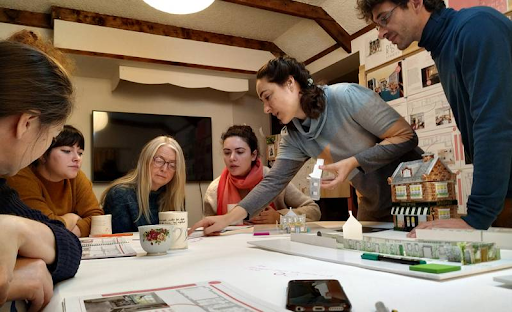
Image from: Devron Projects
Deveron Projects, located in the rural market town of Huntly, Scotland, follows the ‘town is the venue’ framework in which the organisation “works and contributes to the social wellbeing of [their] town” (Deveron Projects, n.d.-a, para.1). Their work is rooted in “Huntly’s small-town context, its 18th-century streets and the surrounding Aberdeenshire countryside” which “offers an abundance of opportunities to work with” (Deveron Projects, n.d.-a, para.1). Within their ‘town is the venue’ framework, Deveron Projects (n.d., para. 10) and those that work there are ingrained in the town - the artists and art workers live and work in the town with the belief that “[b]eing part of local life helps create a better understanding of the culture, its strengths, its problems and how they can be solved”. The Square Deal, one of the current projects that Deveron Projects is pursuing, aims to regenerate and utilise the “much-loved heritage building” - Square Deal - as a “home-from-home for interns and artists; a civic space for regular events; a crafted garden for art and ecology; and an active presence in Huntly town square” (Deveron Projects, n.d.-b, para. 1-2). Deveron Projects has been working with Aberdeenshire-based architect Jill Andrews, quantity surveyor John Pascoe, and social architect-designers Drassana.
3.3 How is Creative Placemaking expressed?
Several different methods, activities and actions take place in the Creative Placemaking process. These can be described as expressions of Placemaking (Cohen et al., 2018). According to Lew (2017), these expressions can be categorised as Tangible Expressions, Intangible Expressions or a combination of both (i.e., Mixed Expression).
1) Tangible Expression: A Tangible Expression pertains to the physical design of a place, including natural landscapes and builtscapes. Case Study 2, below, is used to exemplify a Creative Placemaking activity that could be categorised as a Tangible Expression.
2) Mixed Expressions: Because the expressions are situated on a continuum, Lew (2017) notes that there are expressions that combine both the tangible and the intangible. They fall into the category of Mixed Expressions and are shaped by what Lew (2017) describes as ‘people practices’, as well as ethnoscapes and peoplescapes. These ‘people practices’ are often seen in the “everyday practices of people who occupy these planned places” (Lew, 2017, p.456).
Case Study 2: ‘Home + Away’, Vancouver, Canada
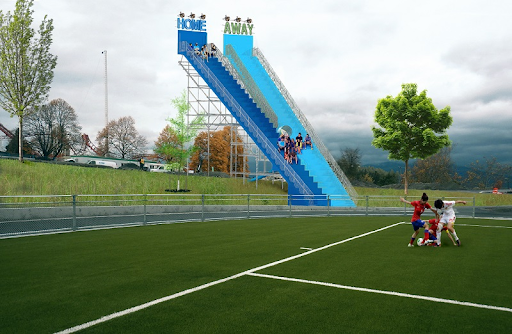
Image from ‘Home + Away’, Vancouver, Canada
The ‘Home + Away’ installation planned in Vancouver’s second-largest park, Hastings Park, is meant to create an iconic landmark for the community (Harman, 2018). Artists, Annie Han and Daniel Mihalyo of Lead Pencil Studio were brought on to the project through the City’s Public Art Program (Cite of Vancouver, n.d.). The artwork’s design was influenced by “early public consultations” and was developed in response to a “desire for seating and play architecture” (Cite of Vancouver, n.d., para. 13). This installation is part of a much larger piece of Placemaking aimed at transforming the space into a “greener, year-round destination for park use, culture, sport, recreation and fun” (Harman, 2018, para.7).
Case Study 3: ‘Placemaking Through Heritage’, Cumbernauld Village, Scotland
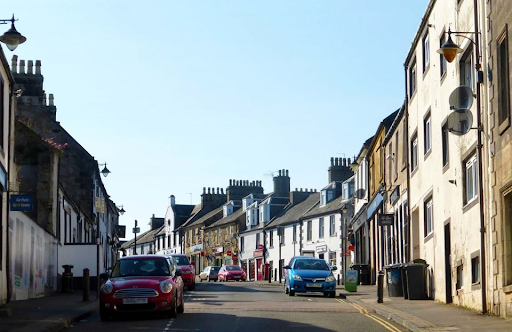
image from ‘Placemaking Through Heritage’, Cumbernauld Village, Scotland
Keep Scotland Beautiful’s Placemaking Through Heritage Project, which started in 2020, is a three-year project which aims to “inspire a creative and vibrant Scotland - motivating local residents to become more involved in looking after, protecting and managing their local place for generations to come” (Keep Scotland Beautiful, n.d., para.3). The project, which is funded by Historic Environment Scotland, will take place in a number of different communities aiming to provide an experience that is “tailored to each place” (Keep Scotland Beautiful, n.d., para.4). In Cumbernauld Village, the organisers are working with people from the community to “record some of the historic buildings in the area and learn more about how the Village has changed over time”. Keep Scotland Beautiful (n.d.) notes that the images and stories that are collected through this process will be used to tell the story of the village.
Table 3 provides some more examples of Tangible, Mixed and Intangible Expressions of Creative Placemaking.
| Tangible | Mixed | Intangible |
|---|---|---|
|
|
|
Table 3: Examples of Placemaking Expressions (Sources: Lew 2017 and Cohen et al., 2018)
4.0 Outcomes and Impact
4.1 What are Creative Placemakers aiming to achieve?
In short, Creative Placemaking intends to use arts and culture to advance the quality of life in a specific area, but as Beaulieu (2014, p.1) notes “what does ‘quality of life’ mean and how is it measured?”. While the challenge of measuring outcomes was discussed earlier in developing metrics for performance and evaluation, Wyckoff et al. (2015) and many other authors have also highlighted that identifying the purpose of a Placemaking process is incredibly challenging to pinpoint as well. Some authors such as Cohen et al. (2018), have tried to synthesise the types of intended impacts associated with Creative Placemaking into the three overarching categories of Environmental focus, Social focus or Economic focus. Others like Beaulieu (2014) and Delconte et al. (2016) support the widely used Community Capital framework (CCF) for understanding the potential impacts on the quality of life in a community. CCF emphasises that “the lifeblood of any community can be linked to the presence and strength of seven community capitals” (Beaulieu, 2014, p.1). The seven capitals in CCF are as follows:
- Natural
- Cultural
- Human
- Social
- Political
- Financial
- Built
Wyckoff et al. (2015) suggest a similar framework highlighting six major categories in which the intended purpose of Placemaking projects might fall. These include:
- Economic Development
- Infrastructure Development
- Community Development
- Health and Recreation
- Arts, Culture and Entertainment
- Public Spaces
Wyckoff et al. (2015) note that all four types of Placemaking could be used to accomplish these outcomes, but that some are more suited to accomplish specific outcomes than others. They highlight Creative Placemaking as particularly well suited to Health and Recreation, Arts, Culture, and Entertainment and Public Spaces. Other authors have advocated for Creative Placemaking as a tool for economic and community development as well (Markusen & Gadwa Nicodemus, 2014). Table 4 illustrates how the impacts identified by Beaulieu, Delconte et al, Wyckoff et al. and Cohen et al. are intertwined and provides several examples.
| Environmental | Social |
Economic |
|---|---|---|
|
Natural, Built, Infrastructure Development, Public spaces |
Cultural, Human, Social, Political, Health and Recreation, Community Development, Arts, Culture and Entertainment |
Financial, Economic Development |
|
Examples include:
|
Examples include:
|
Examples include:
|
Table 4: Types of Impacts Associated with Creative Placemaking (Sources: Delconte 2014, Wyckoff et al. 2015 and Cohen et al., 2018)
It is important to note, that while a Creative Placemaking project might have a focus on one of the three categories, it is plausible if not entirely likely that the project will impact several different outcome areas (Kobersmith, 2021).
5. Creative Placemaking in Practice
5.1 Best practice in Creative Placemaking
5.1.1 What are the characteristics of successful Creative Placemakers
Presented below is a list of the characteristics of Creative Placemakers as described succinctly by Vazquez in the (2012) White Paper, Creative Placemaking: Integrating community, cultural and economic development. Vazquez’s paper was written for leaders, researchers, instructors and practitioners to help build the field of Creative Placemaking as such the characteristics outlined are useful when considering areas of best practice in Creative Placemaking. Vazquez writes:
The term ‘Creative Placemaker’s includes everyone who is actively involved in Creative Placemaking, as defined above. Individual skills and talents are not always immediately evident and yet they are probably the most important assets to bring into the process. To achieve their mission, Creative Placemakers:
- are collaborative: Just as no single person can lead and manage all aspects of a society, Creative Placemaking by one person or one interest group is unsustainable. Collaboration should be shared among as many groups as possible within a community.
- are creative and compassionate creators: Creative people can see opportunities and connections that others might not. Creators generate ideas that lead to new ways of thinking and doing. Creative Placemakers are not mere facilitators or technicians; they are actively involved in creating from the beginning of the initiative. But because they are also collaborative, creative Place makers use compassion to temper any desires to make their ideas rise above others.
- are culturally competent: Creative Placemakers recognize that artists, developers, and elected officials, as well as distinct communities, can have very diverse hierarchies of values and tolerances of risk. Effective Creative Placemakers understand and respect these differences, and engage in strategies that meet the diverse interests of stakeholders to build consensus for action.
- intend to guide, but not control, market activity: No one can accurately predict the comprehensive array of transactions that is called “the market.” But all human activity is guided by awareness, intent, action, reflection, and response. Through such activities as market analysis, thought leadership and place marketing, Creative Placemaking works to understand the values, interests and concerns of audiences, and to address them in ethical, sustainable ways.
- recognize that shaping awareness and beliefs is as critical as shaping the built environment: One of the reasons that the Municipal Art and City Beautiful movements of the late 19th and early 20th centuries could not achieve broad, sustainable results is that their members put too much emphasis on physical determinism – the theory that social behaviour can be predicted and directed through changes in the built environment. A person’s willingness to risk time, energy, money and other resources depends on his or her values, beliefs, perceptions, tolerance of risk, and experiences. The physical environment is only one of several elements that impact a person’s willingness to engage in a place.
- value, and promote the value of creative processes and creators: Creative Placemakers seek to produce sustainable and predictable outcomes through processes that have internal order and can be managed. Creativity is inherently disorderly and unpredictable. Creative Placemakers strive to balance idea generation with idea resolution and seek to build the capacity of others to get more comfortable with the yin and yang of Creative Placemaking. (Vazquez, 2012, pp.16-18)
5.1.2 What are the characteristics of best practices in Creative Placemaking?
It is important to recognise what has underpinned this entire paper: that Placemaking, like homemaking, is not a ‘one size fits all’ strategy. The term’s own definition is malleable and is meant to encompass a wide range of approaches, methods and activities depending on the intended outcome. That being said, an effort to amalgamate best practices in current Creative Placemaking endeavours has been made. A number of the referenced authors’ insights have been synthesised into the following list of best practices.
1) Recognise the significance and value of the process: At the beginning of this paper, the common thread amongst the various definitions of Placemaking was that it is a process that generates quality places. A review of the literature on good or best practices in the specialised field of Creative Placemaking highlights that it is an ongoing process (Borrup, 2016; UN Habitat, 2020) that requires continued “improvement and innovation to keep the community engaged and [ensure] that you are meeting their needs'' (URBN Design, 2021, para. 9). The PPS provides similar advice noting that by nature, good public spaces “respond to the needs, the opinions and the ongoing changes of the community [that] require attention”. It is important to be open to the need for change and to understand that Creative Placemaking does not end when a single project is finished.
2) Think holistically about the goals of the space: As Borrup (2016, p.7) highlights, Creative Placemaking brings “new dimensions and new tools to localized planning, community development, and community animation in the century-long drive to think more holistically about the goals of making space”. A number of texts that have highlighted best practices in Creative Placemaking noted the importance of having a vision (PPS, n.d.; Wyckoff, 2015; URBN Design, 2021). Within that, it was stressed that the vision needs to be specific to each individual community and take into consideration what the community needs are. Creative Placemaking is considered at its best when the “community shares a compelling vision for its future” and finds the common ground between different stakeholder goals (Greenspace Scotland, 2018, para. 13). Whittemore (2016, p.1) highlights “[c]ommunity-oriented strategies serve the needs of lower-income communities, providing venues for education, arts incubation, and community participation and activism”. At the moment, “entrepreneurial strategies dominate when it comes to promoting the arts in US cities, despite the potential diverse contributions of Creative Placemaking strategies'' (Whittemore, 2016, p.1).
3) Build on the uniqueness of a place: Many projects perceived as successful or examples of best practice build on the uniqueness of a place, nurturing distinctive qualities and resources that already exist (Markusen & Gadwa Nicodemus, 2014, Wyckoff et al., 2015). URBN Design (2021) suggests “radical listening is an important and beneficial skill” in the Creative Placemaking process. This includes utilising and leveraging the local cultural, historical and aspirational assets in the community itself. As Markusen and Gadwa Nicodemus (2014) note, “[a] culture-based revitalization effort must be appropriate to its local circumstances, not a ‘me, too’ replica of what other cities and towns are doing”.
4) Involve multiple partners from multiple sectors: Collaboration was highlighted as a key feature of Creative Placemaking. In this section, we highlight the importance of including a vast selection of partners. This practice was identified by a number of organisations and academics, including the PPS (n.d.), which identified both Looking for partners and engaging local artists within their 11 Principles for Creating Great Community Places. Whittemore (2016, p.6) highlights that “[w]hile Creative Placemaking can revolve around large flagship institutions, it is most effective when decentralized”. Creative Placemaking should build connections between people and places by encouraging collaboration. When integrating arts and culture into a project, it is important to understand and accept that you will need input and additional skills from a variety of different cross-sector partnerships. This means leaving the individual silo of your sector and getting out into the community, aiming to include artists, community members, foundations organisations, and the local government in all phases of the project (Borrup, 2016; URBN Design, 2021).
5) Realise that the community is the expert: Another one of the PPS’ (n.d., para.3) 11 Principles for Creating Great Community Places includes realising “the community is the expert”. Some authors suggest that getting in touch with the people in the spaces you are working in is the most important aspect of Creative Placemaking practice (UN Habitat, 2020; URBN Design, 2021). These are the people who can “provide historical perspective, valuable insights into how the area functions, and an understanding of the critical issues and what is meaningful to the people'' in that space (PPS, n.d., para.3). Creative Placemaking is at its best when residents can be involved in connecting their culture to the project. This is an important aspect as it creates a sense of community ownership and ensures that the project or activity addresses the needs of the community (Hilliard, 2021). As McCormack (2019, para.5) notes “[it’s] better still when the community catalyses the event, and participates in planning and implementing it”. McCormack (2018, para.19) highlights that “artists need to understand that when they come into a place, they are not the first ones there, there’s a long history that pre-exists them—and what they do can impact that place in ways they may not intend”.
6) Consider who might be missing from the table: In their (2014) paper Creative Placemaking: How to do it well, Markusen and Gadwa Nicodemus highlight that there were some characteristics that they would improve four years after they originally wrote the white paper on Creative Placemaking. They emphasise the importance of equity in the practice, stating “Creative Placemaking initiatives should be designed to expand opportunities for low-income communities, people of color, and artists. They should also take care not to displace (either directly or via property value and rent escalation) existing residents, their practices and cultural gathering places'' (Markusen & Gadwa Nicodemus, 2014, p.41). As Borrup (2016, p.3) notes “[e]ffective Creative Placemaking must generate, among other things, this sense of belonging”. When attempting to achieve this feeling of belonging, it is important that inclusion be a fundamental tenet in the practice and to consider who might be missing from the table. McCormack (2018, para.26) answered the question “how do you constantly make sure you’re not missing people’s voices'' by stressing that this is an action that takes effort. He explains that “[y]ou send community organizers knocking on doors and talking to people to bring the information back. You set a table that’s so appealing people want to come. You don’t ask people for their feedback on something that’s already been made. You ask them to start with you at the beginning”.
6. Creative Placemaking in Rural Contexts
Stern (2014, p.84) points to a notable feature in Markusen and Gadwa Nicodemus’ definition of Creative Placemaking, highlighting the “absence of any clear spatial element”. With this in mind, Markusen and Gadwa Nicodemus (2010, p.6) argue that “Placemaking can occur at scales as large as a multi-state region and as small as a rural town or city neighbourhood”. Case Study 4 and Case Study 5 below illustrate the scalability of Creative Placemaking.
Case Study 4: Seven Saints of St Paul's, Bristol England
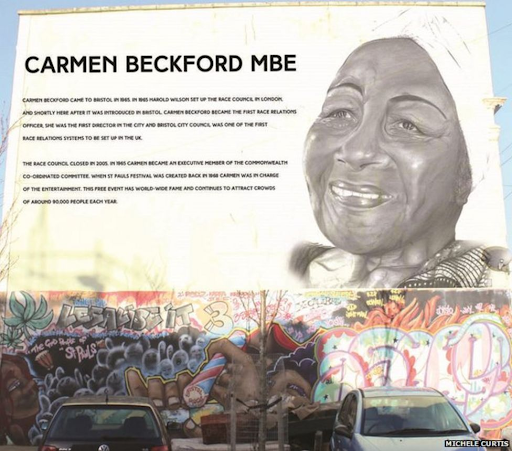
Image from: Placemaking through heritage
After a three-year hiatus, the St Paul’s Carnival returned to the streets of the inner suburb of Bristol for its 50th anniversary (Harman, 2018). As part of the 50th anniversary, local artist Michele Curtis spearheaded ‘The Seven Saints of St Paul’s project. In this project, “murals honouring seven key people who shaped Bristol’s black community, including those who helped create the St Paul’s Carnival and others who campaigned for equality in 1960s Bristol” (Harman, 2018, para. 31). The murals have been regarded as an example of “the power of Placemaking to build a sense of shared community heritage” (Harman, 2018, para. 32).
Case Study 5:'Playable City', Bristol England
Though situated in the same city as Case Study 4, the last of the case studies presented in this paper, is of a much larger scale. The Playable City, a term and method coined by the Bristol media and arts venue - Watershed, has been adopted in cities all around the world. The Playable City method seeks to re-use city infrastructure and re-appropriate it with “smart city technologies to create connections” (Watershed, 2017, para.1). The method is meant to find “new ways of connecting city-dwellers - both with each other and with the urban environments in which they live” (Harman, 2018, para. 33). In Bristol, the Playable City incorporated a number of different projects and creative installations throughout the entirety of the city intending to unlock social dialogue and bring the citizens into city development conversations (Watershed, 2017).
Wyckoff et al. (2015) suggest that Placemaking, in general, can occur in six primary locations, which they call ‘Transects’. Transects is a term borrowed from architects, planners and New Urbanists to describe a location based on its relative density, natural, and/or built characteristics. Within this typology, Wyckoff et al. (2015) suggest that all places across the globe will fall into one of the six transects. Below the transects are described in order of most rural to most urban. Wyckoff et al. (2015) categorise the first two transects as zones with rural contexts and transects three through six as zones with urban contexts. Below, Figure 2 illustrates the transect zones, followed by short definitions and characteristics of each zone.
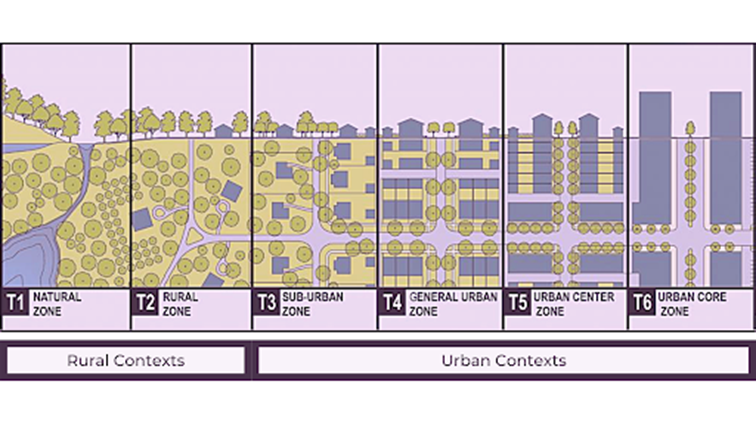
Figure 2: The Transect Zones (Source: The Center for Applied Transect Studies, 2008)
- Natural Zone (Transect 1): This includes wilderness, forests, undisturbed shorelines, and other natural landscapes. As Wyckoff et al. (2015, p. 47) describe “[t]his is where nature rules and humans often stand in awe and wonder”.
- Rural Zone (Transect 2): This zone can include farms, woodlands, wetlands, streams and large regional parks. The landscape in these areas tends to consist of working land along with the farmsteads of people who live off the land. The roads tend to increase and shift from gravel to paved roads as one gets closer to small towns in the area (Wyckoff et al., 2015).
- Sub-Urban Zone (Transect 3): This zone can include larger single-family homes, home occupations, and some mixed-use spaces. It is common to find larger homes in subdivisions surrounded by commercial buildings containing dozens of retail stores and personal establishments. Wyckoff et al. (2015) suggest that the landscape design in this zone favours vehicles over people and is often dominated by roads and car parks. This area is largely residential but may contain retail, personal service establishments, and coffee shops on the ground floor and apartments on the first, second and third floors (Wyckoff et al., 2015).
- Urban Centre Zone (Transect 5): This zone can include wide housing choices, mixed-use spaces, retail shops, galleries, offices, restaurants, and bars. Traditionally, this zone caters to retail, office and other business activity. They often include civic spaces like town squares which are commonly used for public gatherings and where parades originate, terminate or both (Wyckoff et al., 2015)
- Urban Core zone (Transect 6): This zone can include tall multi-use buildings, cultural and entertainment districts, and civic spaces for parades and festivals. As Wyckoff et al. (2015, p.49) note “only the largest of cities have an urban core place, and it may double as the downtown”. This zone is often an employment hub with many office jobs that are concentrated in a few tall buildings.
6.2 How does this correlate with definitions of rurality in Scotland?
Since the concept of transects is borrowed from architectural, planning and New Urbanist fields, the definitions offered by Wyckoff et al. (2015), though a helpful place to start, seem to fall short of providing the entire background needed to understand Creative Placemaking in rural contexts in Scotland. Not only are the definitions American-centric, but they are also based on physical characteristics and therefore fail to correlate with what those in Scotland commonly identify as 'rural' in terms of a place's accessibility and connectivity.
In Scotland, rural classification is based on both relative density and accessibility. Areas with fewer than 3,000 people are classified as rural. In addition to this, “[a]ccessibility is measured in terms of drive times to an urban area. This is done by calculating 30 and 60 minute drive times from the population-weighted centroids of Settlements with a population of 10, 000 or more (i.e., Large and Other Urban Areas)” (Scottish Government,2016, p.4). Scotland’s Urban Rural Classification combining both population and accessibility measures is shown in Table 5 below.
| Class | Class Name | Description |
|---|---|---|
| 1 | Large Urban Areas | Settlements of 125,000 people and over. |
| 2 | Other Urban Areas | Settlements of 10,000 to 124,999 people. |
| 3 | Accessible Small Towns | Settlements of 3,000 to 9,999 people, and within a 30 minute drive time of a Settlement of 10,000 or more. |
| 4 | Remote Small Towns | Settlements of 3,000 to 9,999 people, and with a drive time of over 30 minutes but less than or equal to 60 minutes to a Settlement of 10,000 or more. |
| 5 |
Very Remote Small Towns |
Settlements of 3,000 to 9,999 people, and with a drive time of over 60 minutes to a Settlement of 10,000 or more. |
| 6 |
Accessible Rural Areas |
Areas with a population of less than 3,000 people, and within a drive time of 30 minutes to a Settlement of 10,000 or more. |
| 7 |
Remote Rural Areas |
Areas with a population of less than 3,000 people, and with a drive time of over 30 minutes but less than or equal to 60 minutes to a Settlement of 10,000 or more. |
| 8 |
Very Remote Rural Areas |
Areas with a population of less than 3,000 people, and with a drive time of over 60 minutes to a Settlement of 10,000 or more. |
Table 5: Scottish Government Urban Rural Classification (Source: The Scottish Government, 2016, p.5)
For this paper, the broader, ‘rural contexts’, will be used rather than Wyckoff et al.’s (2015) individual transect zones (i.e., Natural Zone or Rural Zone) or the Scottish Governments (2016) individual classes (i.e., Accessible Rural Areas, Remote Rural Areas, or Very Remote Rural Areas) as it accommodates movement on the spectrum of rurality.
6.3 Why use Creative Placemaking in rural contexts?
Areas in rural contexts face different challenges than their more urban counterparts (BBC, n.d.). These challenges can range from retention of high street business and challenges to digital access (Local Initiative Support Corporation, n.d.). Creative Placemaking has been positioned by a number of organisations as a method uniquely capable of addressing these challenges (National Endowment for the Arts, 2011; PPS, 2015; PPS, 2016; Local Initiative Support Corporation, n.d.). This is because Creative Placemaking is perceived as a “scalable and personalized framework for ambitious community development projects” and empowering for rural communities who wish to make changes and face challenges on their own terms. As the PPS (2016, para.2) notes “developing locally-driven solutions to … challenges is critical to the long-term vitality of these communities”. They also highlight that Creative Placemaking can “help foster local identity, inspire community pride, and increase patronage to local business” as well as “help foster place attachment and encourage young people to stay in their communities” (2016, para.2).
Gadwa Nicodemus (2014, para. 2) argues that rural communities, similarly to low-income neighbourhoods, “struggle with the stigma of deficiency-based narratives. Yet, rural communities also host unique assets”. Rural spaces have the ability to foster an incredible sense of community and connectedness. Within this, rural landscapes are perceived to play a major role in the identity of many small towns (PPS, 2015). As Gadwa Nicodemus (2014, para.3) highlights “rural landscapes offer some of our last bastions of distinctiveness. Some rural communities have also retained cultural practices outside of the mainstream, such as craft artisanship, and language, dance, and culinary traditions”.
6.4 How is Creative Placemaking implemented in rural contexts?
The features of Creative Placemaking (a place-based orientation, a core of arts and cultural activities and a focus on collaboration and co-creation) are integral to the practice in a rural context. In this context, Creative Placemaking faces the additional challenge of heightened community scepticism which manifests in parochialism and fear of outsiders (Gadwa Nicodemus, 2014). The third feature, a focus on collaboration and co-creation, along with peer-to-peer learning is considered essential as “rural people prefer to learn from each other rather than an outsider coming in and telling them what to do” (Gadwa Nicodemus, 2014, para. 7). Gadwa Nicodemus (2014) suggests that when considering how to implement Creative Placemaking practices into spaces with a rural context, successful initiators often root their strategies in arts and cultures but ensure that shared community values are linked. They also seek to leverage distinctive cultural traditions while considering the natural assets and agricultural practices (Gadwa Nicodemus, 2014). The PPS (2016, para.7) notes that “partnerships between sectors [are] central to making rural areas thrive”, Davis (2020) similarly highlights the importance of identifying common ground, highlighting best practices such as having a shared vision and seeking to co-create shared narratives.
7. Conclusions
7.1 How can we categorise Creative Placemaking activities?
One of the main goals of this paper was to produce some way of typifying Placemaking activity. While much of the first half of the paper highlights the difficulties that arise when attempting to do so, Figure 3 attempts to provide an illustration of how one might begin to categorise their Placemaking efforts. This flowchart was loosely inspired by Wyckoff’s (2014) Placemaking Decision flowchart
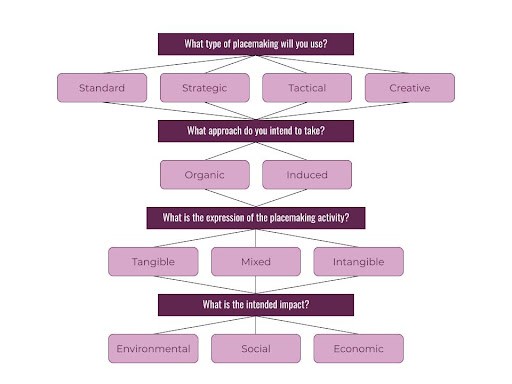
Figure 3: Creative Placemaking Flow Chart (Adapted from Wyckoff, 2014, p. 9)
In a similar style to Wyckoff (2014), the case studies presented in this paper have been used as examples in Table 6 to illustrate how one might use the categorising method presented above. The questions in the flow chart refer to the categories discussed earlier in this paper, however, there are other aspects that might help narrow down the type of Placemaking activity. Other questions one might add to the flow chart include:
- Which transect is it taking place in?
- Is it in the public or private realm?
- Who are the stakeholders involved?
- Who is the initiator of the activity?
- Who will benefit from the activity taking place?
| What is the name of the project or activity? | What type of Placemaking will you use? | What approach do you intend to take? | What is the expression of the Placemaking activity? | What is the intended impact? |
|---|---|---|---|---|
| The Square Deal | Creative Placemaking | Organic | Tangible | Environmental / Social |
| Home + Away | Creative Placemaking | Induced | Tangible | Environmental / Social |
| Placemaking Through Heritage | Creative Placemaking | Unknown | Intangible | Social |
| Seven Saints of St Paul’s | Creative Placemaking | Organic | Tangible | Social |
| The Playable City | Creative Placemaking | Induced | Mixed | Environmental / Social |
Table 6: Examples of Creative Placemaking categorised using the flowchart (Adapted from Wyckoff, 2014, p. 10)
7.2 What has been covered in this paper?
This paper opened with a comment on the ineffable nature of the term Placemaking. After reviewing the literature, the adaptability of the term proved to be almost purposeful in order to encompass the wide range of approaches used by a wide range of stakeholders. The four-part categorisation made by Wyckoff (2014) and a number of other authors provides a good starting point for discussion, however, it is imperative to understand that in practice, “there is much slippage between these various forms of Placemaking” (Cohen et al., 2018, p. 51). To go back to the analogy of homemaking seems a good place to start these concluding remarks.
The features of Creative Placemaking were identified as a place-based orientation, a core of arts and cultural activities, and a focus on collaboration and co-creation. The first suggests the use of a Placemaking process and the second adds arts and culture into the mix. The final feature seems aimed at counteracting two of the three challenges highlighted in this paper. These are avoiding displacement and gentrification and countering community scepticism. The third challenge was identified as developing metrics for performance and evaluation was perceived as tied to the considerable variations in Placemaking activity.
The next phase of categorisation was based on Lew’s (2017) suggestion that there are two approaches: an Organic, bottom-up approach or an Induced, top-down approach. It was noted that an Organic approach was favoured by most practitioners but as Lew (2017) highlights the action of planning a Placemaking effort removes its ability to remain entirely organic. Lew (2017) also provided the framework for categorising the ways that Creative Placemaking can be expressed into Tangible, Intangible and Mixed Expressions.
In seeking to answer, “what are they looking to achieve with Creative Placemaking”, the difficulty of measuring the outcomes of such activities became present once again. After exploring frameworks from Beaulieu (2014), Wyckoff et al. (2015), Delconte et al. (2016), and Cohen et al. (2018), this paper broadly categorises the intended impacts into those with an environmental focus, a social focus and/or an economic focus
In summarising the final section of this paper, Creative Placemaking in practice, it feels logical to include Lew’s (2017) warning: “The intentionality of Placemaking ... requires an awareness of the social consequences of planned change” (Lew, 2017, p.455). It seems evident that Vazquez’s (2012) Characteristics of Creative Placemakers and the summary of best practices are aimed to combat the unintended consequences that Lew (2017) alludes to.
This paper provides an overview of how Placemaking can be understood as a concept and touches briefly on Creative Placemaking in practice. Further research might need to be undertaken to understand how this occurs within specific contexts – for example, in rural or remote settings – to sense-check this literature and explore how such activities occur in contextual, localised and ‘real-life’ settings.
Beaulieu, L. J. (2014). Promoting community vitality & sustainability: The community capitals framework. Purdue University.
Borrup, T. (2016). Creative placemaking: Art and culture as a partner in community revitalization. In Fundamentals of Arts Management (pp. 1–22). University of Massachusetts
City of Vancouver. (n.d.). Home + away: In-depth. Vancouver.Ca.
Creative Scotland. (n.d.). Culture collective fund. Retrieved November 3, 2021,
Davis, J. (2020). Common ground: How can arts and culture create space for collaboration and partnership in rural and small town settings [Slides]. Local Initiatives Support Corporation.
Deveron Projects. (n.d.-a). Deveron projects: The town is the venue - deveron projects.
Deveron Projects. (n.d.-b). Drassana : The square deal - deveron projects.
Gadwa Nicodemus, A. (2013). Fuzzy vibrancy: Creative placemaking as ascendant US cultural policy. Cultural Trends, 22(3–4), 213–222.
Gadwa Nicodemus, A. (2014). Small is beautiful. Grantmakers in the Arts.
Greenspace Scotland. (2018, May 16). Community placemaking.
Grodach, C., Foster, N., & Murdoch, J. (2014). Gentrification and the artistic dividend: The role of the arts in neighborhood change. Journal of the American Planning Association, 80(1), 21–35.
Keep Scotland Beautiful. (n.d.). Placemaking through heritage.
Kresge Foundation. (n.d.). Breaking down creative placemaking. Kresge. Retrieved November 16, 2021,
Lew, A. A. (2017). Tourism planning and place making: Place-making or placemaking? Tourism Geographies, 19(3), 448–466.
Local Initiative Support Corporation. (n.d.). Rural placemaking.
Markusen, A, & Gadwa Nicodemus, A. (2010) Creative Placemaking: Executive Summary. Washington: NEA.
Markusen, A., & Gadwa Nicodemus, A. (2014). Creative placemaking: How to do it well. Community Development Investment Review, 10(2), 35–42.
McEwan, K. (2021, May 26). Region chosen for national culture programme. The Stove Network.
Moore, Z. E. (2020). What is placemaking? Definition & examples. Spaces to Places. Retrieved November 9, 2021,
National Endowment for the Arts. (2016). How to do creative placemaking.
Project for Public Spaces. (2005). Placemaking symposium in vancouver, december 16.
Project for Public Spaces. (2007). What is placemaking? Retrieved October 29, 2021
Project for Public Spaces. (2015). National main street center and project for public spaces co-sponsor summit with white house to boost placemaking in rural communities.
Project for Public Spaces. (2016). Placemaking on main street: Revitalizing rural communities.
Richards, G. (2011). Creativity and tourism. Annals of Tourism Research, 38(4), 1225–1253.
Scottish Government. (2016). Scottish government urban rural classification 2016.
Scottish Government. (2020, January 10). Place principle: Introduction. Gov.Scot. Retrieved July 1, 2022,
Scottish Government. (2022, March). Delivering economic prosperity.
Steuteville, R. (2016, January 22). Four types of placemaking. CNU. Retrieved October 29, 2021,
Tate. (n.d.). Socially engaged practice – art term.
UN Habitat. (2020). Placemaking toolkit: Designing people places. https://unhabitat.org/sites/default/files/2020/04/placemaking_toolkit_eng_27042020.pdf
Watershed. (2017, May 30). Vision. Playable City. https://www.playablecity.com/
Whittemore, A. (2016). Creative placemaking: A literature review. Carolina Planning Journal, 41, 14–17.
Wyckoff, M. (2014). Definitions of placemaking: Four different types. Planning & Zoning News, 32(3).
Wyckoff, M. A., Neumann, B., Pape, G., & Schindler, K. (2015). Placemaking as an economic development tool. Amsterdam University Press.

